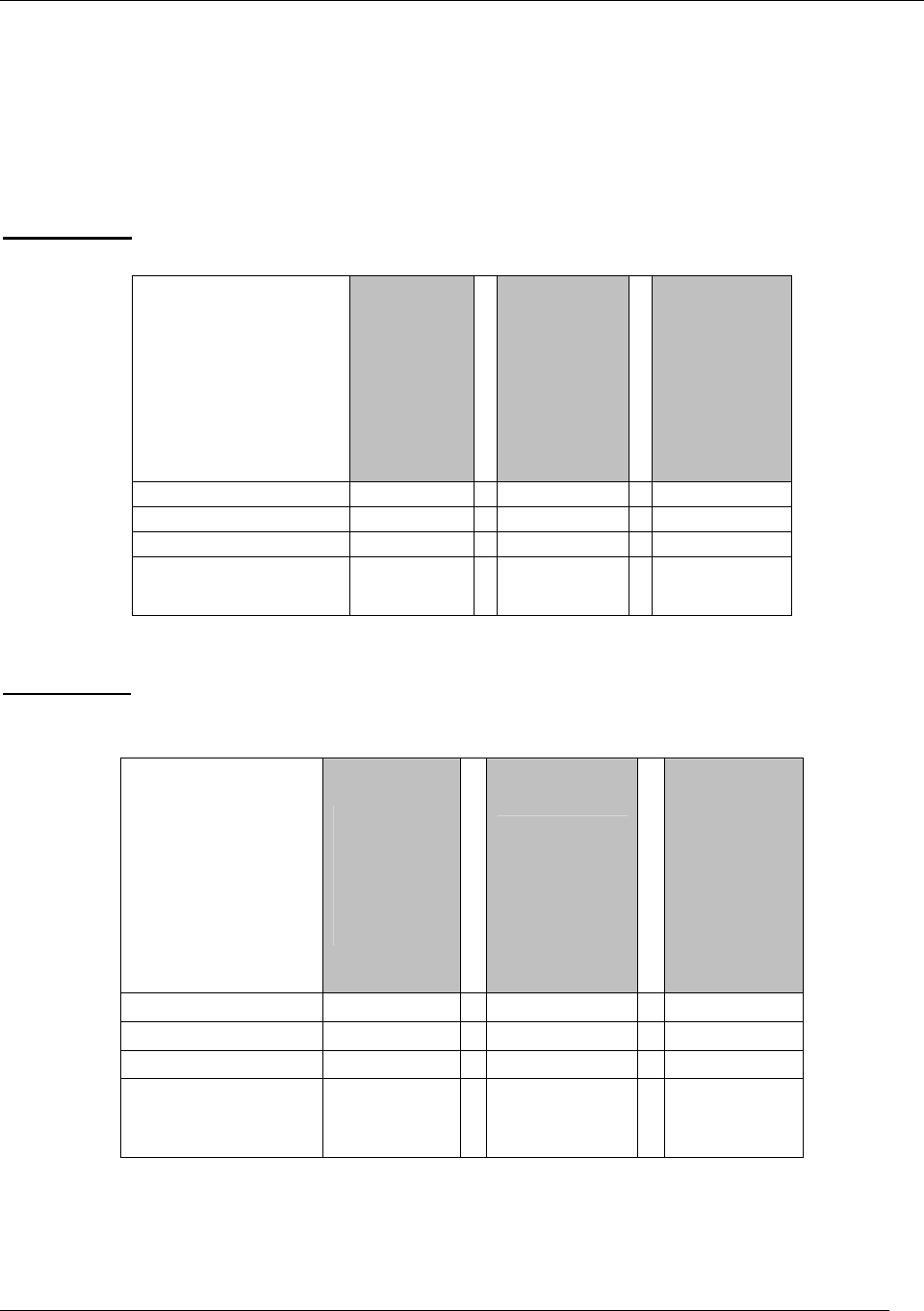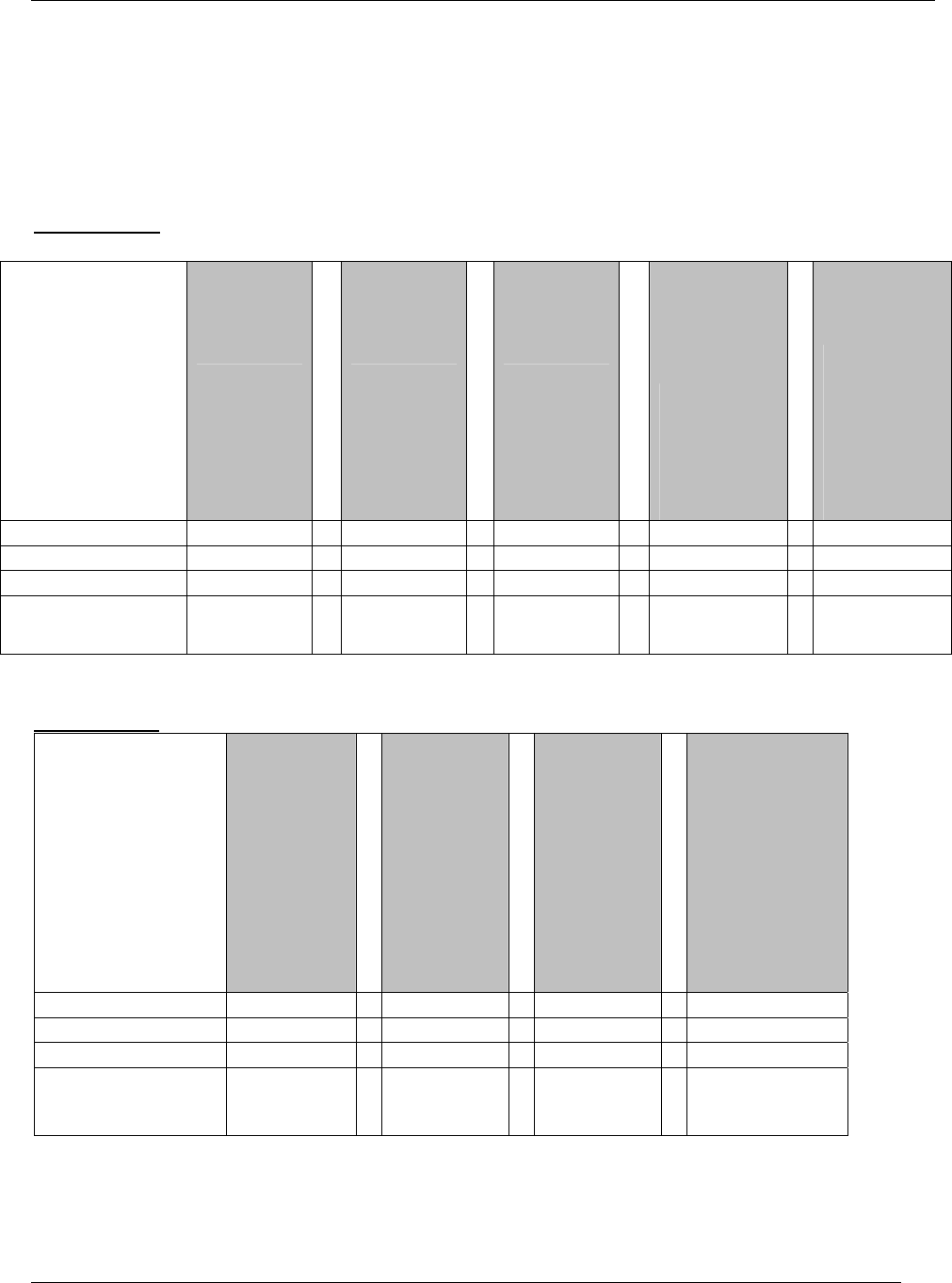
COMMUNITY HOUSING PARTNERS — RESEARCH STUDY REPORT
Prepared by Organizational Options, LLC
Comparative Study
Research Shows the Cost Benefits of Resident
Services on the Performance of Property
Operations
Community Housing Partners
Fiscal Years 2006 and 2007
Research conducted by Terry Galpin-Plattner, Principal, Organizational Options
In collaboration with Community Housing Partners and NeighborWorks
®
America
April 15, 2009 Page 1 of 23

COMMUNITY HOUSING PARTNERS — RESEARCH STUDY REPORT
Prepared by Organizational Options, LLC
In collaboration with Community Housing Partners and NeighborWorks
®
America
April 15, 2009 Page 2 of 23
Introduction
In 2008, Community Housing Partners (CHP), with funding and research support from
NeighborWorks
®
America, engaged in a study to better understand the financial impact of
Resident Services (RS) on property performance in service-enriched affordable family rental
housing.
In the past, anecdotal evidence has suggested that resident services in affordable family housing
help reduce operational costs by helping families improve their incomes and financial
management, get help when they face crises, comply with rental lease requirements and build
communities beyond housing. This is the third study to support and validate that anecdotal
evidence with concrete data showing that resident services reduce operational costs at properties in
the areas of vacancy loss, bad debt and legal fees.
1
This study finds that operational costs in FY 2006 and 2007 relating to vacancy loss, bad debt
and legal expenses were significantly lower at properties with resident services than at those
without resident services. Savings in these three areas totaled $236/unit per year. An
additional fiscal benefit of $38/unit per year was gained at properties that included Eviction
Prevention Counseling.
2
These combined savings of $274/unit/year almost entirely offset the
full cost of resident services (direct costs + indirect costs) of $279/unit/year.
1. Vacancy loss per unit was 35 percent lower in properties with resident services than in
those without them. The savings were $97 annually per unit/year.
Properties with Eviction Prevention Counseling saved an additional $21 per
unit/year.
2. Bad debt per unit was 49 percent lower in properties with resident services than in those
without them. The savings were $116 annually per unit/year.
Properties with Eviction Prevention Counseling saved an additional $12 per
unit/year.
3. Legal fees per unit were 34 percent lower in properties with resident services than in those
without them. The savings were $23 annually per unit/year.
Properties with Eviction Prevention Counseling saved an additional $5 per
unit/year.
1
The State of Pennsylvania’s Housing Finance Agency conducted a data analysis of the effects of Resident Services
on property performance in 2005. A second study was conducted by Enterprise Community Partners in collaboration
with Mercy Housing in 2007: “Research Demonstrates Positive Impact of Family Resident Services on Property
Financial Performance,” Mercy Housing Inc and Enterprise Community Partners, April 2007. Both studies showed
that over a 2-year period, properties with resident services performed better than those without on three of four
property performance measures examined: legal expenses, bad debts and unit turnover. www.residentservices.org
2
Please see Attachment D, which presents CHP’s Eviction Prevention Protocols and data collection method.

COMMUNITY HOUSING PARTNERS — RESEARCH STUDY REPORT
Prepared by Organizational Options, LLC
In collaboration with Community Housing Partners and NeighborWorks
®
America
April 15, 2009 Page 3 of 23
Summary of Findings:
Initial findings demonstrated that operational costs in FY 2006 and FY 2007 relating to
vacancy loss, bad debt and legal expenses were significantly lower at properties with resident
services than those without resident services.
EXHIBIT A:
The table below shows fiscal data comparing properties with and without resident services.
Resident Services
(RS) Compared With
No Resident
Services
#1
Vacancy
Loss/Unit
2-Year
Average
FY 2006–
2007
#2
Net Bad
Debt/Unit
2-Year
Average
FY 2006–
2007
#3
Legal
Fees/Unit
2-Year
Average
FY 2006–2007
No RS
$274 $235 $68
With RS
$177 $119 $45
$ Difference/Unit
$97 $116 $23
% Performance
Difference
35% lower
costs
49% lower
costs
34% lower
costs
EXHIBIT B: The table below shows fiscal data comparing two subsets of properties with
services: those including Eviction Prevention Programs and those with services that do not include
Eviction Prevention.
Eviction Prevention
(EP) Compared
With No Eviction
Prevention
#1
Vacancy
Loss/Unit
2-Year
Average
FY 2006–2007
#2
Net Bad
Debt/Unit
2-Year Average
FY 2006–2007
#3
Legal
Fees/Unit
2-Year
Average
FY 2006–2007
No EP
$179 $126 $43
With EP
$156 $107 $40
$ Difference/Unit
$23 $19 $3
% Difference
13% lower
costs
15% lower
costs
7% lower
costs

COMMUNITY HOUSING PARTNERS — RESEARCH STUDY REPORT
Prepared by Organizational Options, LLC
In collaboration with Community Housing Partners and NeighborWorks
®
America
April 15, 2009 Page 4 of 23
Summary and Analysis for Savings Categories in FYs 2006 and 2007
The provision of resident services enables CHP to save in the areas of vacancy loss, bad debt and
legal fees totaling $236 per unit/year.
Benefits of Eviction Prevention at CHP Properties With Resident Services
A separate comparison was conducted using only the study group with resident services to learn
more about the potential financial benefits of Eviction Prevention Counseling at CHP. Comparing
only family properties with resident services, we found that resident services properties with
eviction prevention counseling had consistently lower costs than those not offering eviction
prevention counseling, saving an additional $38/unit per year (see Exhibit B). This data
demonstrates the value of including Eviction Prevention in resident services to improve property
operations and implies that this specific service contributes significantly to family stability.
Annual savings (with Resident Services) Costs (with Resident Services)
Vacancy loss: $97/unit (per year) Direct costs: $79/unit (per year)
Bad debt: $116/unit (per year) Indirect costs: $200/unit (per year)
Legal fees: $23/unit (per year)
Total savings: $236/unit (per year) Total costs: $279/unit (per year)
Added EP saving $ 38/unit (per year)
Total savings w/ EP: $274/unit (per year)
Pursuit of Replication
Safe, clean and environmentally sustainable housing and healthy communities is a compelling part
of our national agenda and an urgent need in communities across the United States. The stringent
climate of today’s economy creates even greater urgency in issues of housing and family stability.
To move this agenda forward, we must have a body of quantifiable, credible data that demonstrates
the financial benefits of the affordable housing model offered through CHP and others.
Until recently, this important issue relied entirely on testimony and anecdotal information to
formulate a credible argument for public support and policy change. The stage is set for further
research. The favorable findings of CHP are consistent with the findings from the initial data
analysis of the Pennsylvania Housing Finance Agency and the study conducted by Enterprise
Community Partners in collaboration with Mercy Housing. Systematic documentation of processes
included in this report can enable replication of this research in other settings. Attached is a tool
which outlines process steps to facilitate replication of this research model and promote future
studies in this specific research area (see Attachment E).
Conclusion and Recommended Next Steps
Research on the benefits of resident services in affordable housing, for both the low-income
residents and for the properties, is essential to demonstrate the value of these services to policy
makers, lenders, funders and the public.
This research demonstrates that the provision of resident services can provide real cost savings to
affordable housing property operations that are above and beyond the benefits realized by the
residents themselves. Although they are not a definitive cost/benefit analysis, the results of this

COMMUNITY HOUSING PARTNERS — RESEARCH STUDY REPORT
Prepared by Organizational Options, LLC
In collaboration with Community Housing Partners and NeighborWorks
®
America
April 15, 2009 Page 5 of 23
work strongly demonstrate what practitioners have believed for a long time: services positively
affect the bottom line. This work contributes to the important “case” that, in addition to positive
outcomes for adults and children, affordable housing properties benefit fiscally when RS are
provided at family properties; the savings help pay for the services themselves. The data
demonstrates that properties offering resident services, and particularly those with eviction
prevention counseling, realized significant per unit savings in key performance areas when
compared with properties not offering resident services. The study significantly supports part of
the hypothesis of this study — resident services in affordable family housing help reduce
operational costs in vacancy loss, bad debt and legal fees.
However, part of the hypothesis — that resident services would help reduce general operating
expenses — was not supported. General operating costs on properties with resident services in the
study set were higher than on properties without services, even after taking out the direct expenses
of resident services. This suggests a need to better understand cost dynamics and inconsistent
variables beyond the scope of this study, such as the age, location, and management/maintenance
of a property, that influence general operating expenses. A longer-term and more rigorous study
could provide additional data and clarity on these comparisons.
This study calls out several issues for continue exploration by leaders interested in the continued
advancement of resident services:
• Opportunities for additional research should be identified. Continued investigation of the
original hypothesis — that properties offering resident services reduce operational costs in
vacancy loss, bad debt, legal fees and general operating costs — will establish better
understanding of critical performance factors that affect affordable housing.
• Further research offers the opportunity to better understand the cost dynamics and
inconsistent variables beyond the scope of this study, such as the age of a property or the
turnover rate at properties with reduced vacancy loss.
• More rigorous efforts to standardize data collection/outcomes measurement and to correlate
select cost categories with types of resident services offered can inform the design of those
services and support investment in resident services.
ATTACHMENTS:
A. Process and Results of Study
B. Data Points Used and/or Desired for Study
C. Data collection Excel workbook as template for continuation of this study (attached separately)
D. Definitions for key project terminology, including Eviction Prevention Protocols
E. Replication process checklist

COMMUNITY HOUSING PARTNERS — RESEARCH STUDY REPORT
Prepared by Organizational Options, LLC
In collaboration with Community Housing Partners and NeighborWorks
®
America
April 15, 2009 Page 6 of 23
Acknowledgements:
This study was designed and conducted by
Terry Galpin-Plattner, Principal, Organizational Options, LLC.
Important assistance was contributed by
Orlando Artze, CFO, Community Housing Partners, Inc.
Kirsten Anderson, VP Asset Management, Community Housing Partners, Inc.
Nona Hipp, VP Housing Management, Community Housing Partners, Inc.
Lindley Higgins, Applied Research Manager, NeighborWorks
®
America
In 2008, CHP, with funding and research support from NeighborWorks
®
America, engaged in this
study to better understand the financial impact of resident services on property performance in service-
enriched affordable family rental housing. A comparative sample of the CHP portfolio was used to
evaluate the hypothesis that resident services in affordable family housing help reduce operational
costs in vacancy loss, bad debt, legal fees and general operating costs. At CHP and other service-
enriched affordable family housing organizations, “resident services” may include such programs as
out-of-school-time programs for youth, adult financial literacy education, and health and wellness
services. CHP provided support for this research through cooperation with, access to, and interpretation
of data; essential assistance in understanding key elements of the CHP portfolio; and implementation
of the study.
Consistent with the mission of CHP and other affordable housing providers, resident services are key
elements in property operations. Many low-income families living in affordable housing need social
services to succeed in housing, build their financial and personal assets, or to help their children
succeed in school. Anecdotal evidence suggests that such services help reduce costs related to turnover
and nonpayment of rent by helping families improve their incomes and financial management, get help
when they face crises, comply with rental lease requirements and build communities beyond housing.
Such reduced costs contribute to the bottom lines of the properties and the owners.
Results of this CHP study are encouraging and suggest significant performance gains in properties with
resident services. We acknowledge, however, that the study is not conclusive. For example, it is
important to note that overall property management costs may be influenced by certain variables
outside the scope of this study, such as newer versus older properties, or variance in state regulations
affecting tenancy and legal costs. The attachments to
this report provide more detail on research design.
Thus, the CHP study makes an important contribution to service-enriched affordable family housing
and enables the industry to better pinpoint operational efficiencies when considering resident services.
Further, documentation from these studies contributes to the development of best practices, helps build
models for replication of this research and ultimately provides important knowledge to the affordable
housing industry.

COMMUNITY HOUSING PARTNERS — RESEARCH STUDY REPORT
Prepared by Organizational Options, LLC
In collaboration with Community Housing Partners and NeighborWorks
®
America
April 15, 2009 Page 7 of 23
ATTACHMENT A
Process and Results of Study
This section describes factors found during the project that influence collecting, compiling and
analyzing data in the study. A more standardized and consistent process will result in more reliable
and credible results and repeatable processes that lead to replication of this research.
The research documented in this paper was built on the approach used by Mercy Housing in
collaboration with Enterprise Community Partners. Anecdotal information indicating that resident
services supports property performance was substantiated in a study in 2007. Mercy Housing, Inc.
and Enterprise Community Partners collaborated on research to determine the impact of resident
services on property performance in affordable family rental housing. The study used a hypothesis
comparable to the one used in this study, reviewing a similar sample of property financial
performance over a period of two fiscal years. The study compared properties with resident
services to properties without resident services, and reviewed a sample of property financial
performances over a period of two fiscal years. Initial findings demonstrated that properties with
resident services reduced property vacancy losses by an average of 33 percent over two fiscal
years, reduced property legal fees by an average of 58 percent and reduced property bad debts by
an average of 30.5 percent during the study period.
3
The CHP property performance research, as well as the Mercy Housing study, involved analysis of
selected property performance data that relates directly to behavior the services are meant to affect.
For example, this study assesses vacancy loss in conjunction with Eviction Prevention Counseling.
Industry standards have not yet been established for many key elements in research like this; for
example, protocols to determine “general operating costs” may vary widely. This means that the
research methods must be designed on a case-by-case basis.
The goal is to compile and compare costs from selected expense categories per unit per year for the
research period in each study group. Most organizations compile and report their operational costs
in a format useful to or prescribed by their investors, thus such a study must locate and transfer
numbers into this design format.
Note that data needed for property operations and data required to study resident services may be
essentially the same data, but they are typically organized differently. This increases the
importance of understanding the specifics of how property operations data are the same or
different from the data used for this kind of study.
Additionally, such studies encounter unanticipated variations in property operations, management
protocols and idiosyncrasies in information. For example, the method used to calculate bad debt
year to year may be different from one portfolio to the next. Thus, the evolving checklist
3
Research Study Report: “Research Demonstrates Positive Impact of Family Resident Services On Property
Financial Performance,” Mercy Housing Inc and Enterprise Community Partners, April 2007.

COMMUNITY HOUSING PARTNERS — RESEARCH STUDY REPORT
Prepared by Organizational Options, LLC
In collaboration with Community Housing Partners and NeighborWorks
®
America
April 15, 2009 Page 8 of 23
(Attachment E) helps troubleshoot and pinpoint potential inconsistencies. Steps in preparation
for this study are listed below, including solutions to potential problems in establishing
comparable data:
• Determine data points for the study: Identify a desirable set of data points to be included
in the analysis. The interests of the primary end user(s) of the reports influence which data
points are most desirable. Some data points desired for this study were not readily
available. Therefore, data points (Attachment B) were prioritized by an advisory group of
project stakeholders.
• Use original data: Original data taken directly from the property accounting database by
the researcher (vs. data reported by the organization or a third party) is desirable. Original
data is less affected by calculation errors and can be structured specifically for this study.
Access to original data also increases accuracy so that study data matches correctly with
database data. In this case, for example, there was a change in CHP bad debt accounting
from FY ‘06 to FY ‘07. This resulted in an inconsistency in how the data was recorded
between two fiscal years. In order to get a comparable number, a new income account was
created for FY 07 called “bad debt collected,” which enabled comparable bad debt data for
2 fiscal years.
For this study, most data was taken directly from Timberline, the CHP accounting database,
and not interpreted by CHP or a third party, such as NeighborWorks
®
Multifamily
Initiative database. CHP staff provided data for costs of general operating and resident
services. These specific numbers were necessary for this study, but were not readily
available through Timberline.
• Standardize definitions and protocols: Inconsistencies in definitions for a particular
expense category can influence the comparability of the data. For example, procedures for
compiling a category of expenses may have changed during the period of the study, or
standardized definitions may not exist or may be verbally communicated on a case-by-case
basis. The extent of these inconsistencies must be considered in selecting data points for the
design of the study. This points to the importance of standardizing definitions and
protocols. In this case, a set of written definitions was developed in cooperation with CHP
staff as a part of the study (Attachment D).
It is also important to note that property management software is not pre-loaded with
standardized process, terminology definitions or protocols. Even with protocols that were
standardized by CHP to strengthen consistency in using the software, Timberline showed
some cells with “no entry” and some cells with “no transaction for this period.” Further
clarification of this potential inconsistency indicated that in both cases there were no
expenses for that period.
• Validate property codes: Verification is required to validate that each property in the
study is a discrete entity. While this information may be known and consistently used
internally, confusion may arise due to possible name and/or property code number

COMMUNITY HOUSING PARTNERS — RESEARCH STUDY REPORT
Prepared by Organizational Options, LLC
In collaboration with Community Housing Partners and NeighborWorks
®
America
April 15, 2009 Page 9 of 23
transitions. For example, this may occur when ownership of a specific property changes
during the period of study. This is necessary in order to have a valid study universe
throughout the period of the study. This study involved a limited number of such instances
and none in the final groups used for the study.
• Validate complete data available: Working within the financial database, the researcher
must be able to locate individual properties and each expense category in order to record
expenses attributed to that property for each category. This was not a problem for the CHP
study.
In some instances, two or more properties may be “clustered” and treated as one discrete
property. This occurs most often with very small properties or properties in close
proximity. In such a case, data for all data categories for each individual property in the
cluster was retrieved from the database before compiling it as a clustered property. In this
study, only one cluster of properties (City Lights) is treated as one discrete property.
Properties that share resident services and/or property management staff are not necessarily
clustered into one discrete property.
• Verify use of consistent software: Software used to manage the data should be the same
for the period of the study; however this is not always the case. It must be determined
whether and how the different software affects the organization of expense categories used
in the study. CHP did not change software during this period.
• Clarify fiscal year structure: The structure of the fiscal year must be understood. Is the
span of the fiscal year the same for all properties in the study? If not, protocols are required
to establish equitable comparisons across fiscal years. In this case, all properties at CHP
have the same fiscal year during the period of study.
Design Features and Method for Comparison Groups
A. “FIRST CUT” COMPARISON
Properties were selected based on specific criteria uniform for both study groups, allowing
continuity of comparison. The first study group is composed of properties without resident
services; the second study group is composed of properties with resident services.. The “first cut”
checklist included the following simple criteria:
• Family properties only, eliminating senior and “special needs” properties from the study
groups.
• Properties for which complete financial data was available in the 24-month study period. In
this case, the CHP database was complete. Therefore, no properties were eliminated from
the study on the basis of incomplete data.

COMMUNITY HOUSING PARTNERS — RESEARCH STUDY REPORT
Prepared by Organizational Options, LLC
In collaboration with Community Housing Partners and NeighborWorks
®
America
April 15, 2009 Page 10 of 23
• All family properties were included regardless of potential influencing factors such as age
of property, location (urban, rural, suburban) financial structure, number of units, average
household income and so on. At a later point in the study, these criteria were refined.
• Properties with resident services were identified and segmented without consideration (at
this point) for types or scope of services offered.
Properties were first organized into two comparison groups, then numbers for the following
selected data sets were compiled into a “first cut”:
¾ Vacancy loss
¾ Bad debt
¾ Legal fees
¾ Security (omitted — see definitions, Attachment D)
¾ Maintenance (omitted — see definitions, Attachment D)
Based on findings in the “first cut,” security and maintenance cost categories were omitted for
different reasons. (see definitions, Attachment D) In both cases, these expense categories were not
easily accessible for this study. Further investigation may make this data more available for future
studies.
B. REFINING THE COMPARISON GROUPS
Review of the “first cut” leads to a closer look at variables as “outliers” or data anomalies that
skew the overall results. We identified these potential characteristics of “outliers” at properties
with the following characteristics:
1. Large number of units (above 120 units)
2. Small number of units (below 25 units)
3. Remote properties
4. High number of children
5. Considered to have “unstable occupancy” during the study, including
* Properties not in the CHP portfolio for the full time period of the study, and
* Properties with extremely high or extremely low operating expenses in one or
more cost category.
This list prompted additional analyses to determine if removing any one of these yielded more
consistent data results when compared to each other and/or compared to the first cut. While all the
characteristics listed above may indeed be influencing factors, greater depth of study is necessary
to validate this more conclusively.
The analyses showed variables and prompted removal of some additional properties to improve the
comparability of the study groups.

COMMUNITY HOUSING PARTNERS — RESEARCH STUDY REPORT
Prepared by Organizational Options, LLC
Properties considered to be experiencing “unstable occupancy” (Item 5 above) during the
period of the study (see definitions, Attachment D). This criteria was identified by noticing
extremely high or extremely low operating expenses in one or more cost category for
individual property data between year 1 and year 2. “Unstable occupancy” causes these
properties to behave differently financially, and they were therefore removed. In particular,
the following was noted:
¾ Operating costs change dramatically during rehab periods when vacancy rates are
likely to be higher and therefore not comparable to more routine leasing situations.
¾ HUD-specific regulations lead to numerous operational cost differences, making
HUD properties unlike others.
Properties with resident services must offer programming continuously throughout the
period of the study. A gap of three months or longer in services caused the property to be
removed from the comparison study.
Wanting a more comprehensive comparison of financial behavior in both study groups, two
additional data sets were added to the study: 1) general operating costs for all properties
and 2) resident services costs for all resident services properties.
General Operating Costs at
Properties Without Resident
Services
General Operating Costs at
Properties With Resident Services
Include: Administrative,
operations and maintenance.
Includes CHP indirect.
Include: Administrative, operations
and maintenance, resident services
program and staff, Americorps, CHP
indirect resident services expenses
Exclude: Taxes, insurance,
utilities, capital expense, debt
service
Exclude: Taxes and insurance,
utilities, capital expense, debt
service
All properties included in this report have the following characteristics:
• Were considered family properties, any number of units in any location
• Were in CHP’s portfolio during the full period of study
• Had “stable occupancy” during the full period of study
• Had complete data available in identified cost categories during the full period of study
• Had continuous resident services available during the full period of study for properties
offering resident services.
Annual Savings (with Resident Services) Costs (with Resident Services)
Vacancy loss: $97/unit Direct costs: $ 79/unit
Bad debt: $116/unit Indirect costs: $200/unit (average)
Legal fees: $23/unit
Total savings: $236/unit Total costs: $279/unit
In collaboration with Community Housing Partners and NeighborWorks
®
America
April 15, 2009 Page 11 of 23

COMMUNITY HOUSING PARTNERS — RESEARCH STUDY REPORT
Prepared by Organizational Options, LLC
In collaboration with Community Housing Partners and NeighborWorks
®
America
April 15, 2009 Page 12 of 23
Family properties without resident services
543 units 9 properties met criteria for this study
Family properties with resident services
961 units 12 properties met criteria for this study
EXHIBIT A: The table below shows fiscal data.
#1
Vacancy
Loss/Unit
2-Year
Average
FY 2006–
2007
#2
Net Bad
Debt/Unit
2-Year
Average
FY 2006–
2007
#3
Legal
Fees/Unit
2-Year
Average
FY 2006–
2007
#4
General
Operating/Unit
2-Year
Average
FY 2006–2007
#5
General
Operating/Unit
2-Year
Average
Less Direct
RS Costs
FY 2006–2007
No RS
$274 $235 $68 $2,684 $2,684
With RS
$177 $119 $45 $2,818 $2,739
$ Difference/Unit
$97 $116 $23 ($134) ($55)
% Difference
35% lower
cost
49% lower
cost
34% lower
cost
5% higher
cost
2% higher
cost
EXHIBIT B: The table below shows fiscal data.
Eviction
Prevention
Compared With No
Eviction
Prevention
#1
Vacancy
Loss/Unit
2-Year
Average
FY 2006–
2007
#2
Net Bad
Debt/Unit
2-Year
Average
FY 2006–
2007
#3
Legal
Fees/Unit
2-Year
Average
FY 2006–
2007
#4
General
Operating/Unit
2-Year Average
FY 2006–2007
No EP $179 $126 $43 $3,244
With EP $156 $107 $40 $2,752
$ Difference/Unit $23 $19 $3 $492
% Difference
13% lower
costs
15% lower
costs
7% lower
costs 15% lower costs

COMMUNITY HOUSING PARTNERS — RESEARCH STUDY REPORT
Prepared by Organizational Options, LLC
In collaboration with Community Housing Partners and NeighborWorks
®
America
April 15, 2009 Page 13 of 23
It should be noted that most service-enriched affordable housing organizations are able to
provide resident services at larger family properties. It is uncommon to find resident services at
family properties with fewer than 40 units. This limits the design of such comparative studies
by causing the number of units to be higher in properties with resident services..
For purposes of this study, general operating costs are defined as costs that CHP can control,
including administrative, property operations, maintenance and legal expenses. Costs not included
in general operations compilation are cost categories not controllable by CHP and thus result in
variables beyond CHP control such as age of property or local and state regulations. Also excluded
are utilities, taxes, insurance, capital expenses and debt services. Vacancy loss and bad debt costs
are also excluded in general operating expenses.

COMMUNITY HOUSING PARTNERS — RESEARCH STUDY REPORT
Prepared by Organizational Options, LLC
In collaboration with Community Housing Partners and NeighborWorks
®
America
April 15, 2009 Page 14 of 23
ATTACHMENT B
DATA POINTS
NOTE: The scope of this study does not allow all data categories to be compiled and correlated against the primary
findings. Therefore, some of the data categories below were not used for this study but are listed here to inform future
work in this field.
DATA CATEGORY AVAILABILE COMMENT
1 Year Built/Rehabbed
Occupancy Date
YES Not used for this study.
2 Total Number of Units YES Primary data used for this study.
3 Types of Support Services YES Eviction Prevention data used and correlated. Other
data not used for this study.
4 Vacancy Losses YES Primary data used for this study.
5 Legal Expenses YES Primary data used for this study.
6 Bad Debt YES Primary data used for this study.
7 Maintenance Expenses YES Cost details available but deeply embedded in financial
database. This data not used for this study.
8 Security Expenses YES Cost details available but security not universally
necessary and thus not consistently incurred across the
CHP portfolio. This data is not comparable and not
used for this study.
9 Per-Unit Operating Expenses Not routinely
available.
Compiled for
this study
Compiled for this study. See full report.
10 Urban, Suburban, Rural NO “Remote” (rural) locations may influence ability to
provide Resident Services. No properties included in
this study were considered “remote” by CHP staff.
Urban and suburban not factors in this study.
11 Average HH Income at Each
Property
NO Not used for this study, however “zero” income (HUD)
properties were excluded.
12 Number of Children at the
Property
qualified Not used for this study.
13 Comparison of Costs to
Evictions and Resident Turnover
qualified Primary data used for this study. CHP uses the standard
that every prevented eviction saves them $1,500.
14 Size of Common Space qualified At individual property records. Consider sq ft/unit. Not
used for this study.
15 Insurance Rates qualified Relates to type of property, type of financing, state law.
Not used for this study.
16 Census Tract YES Not used for this study.
17 Construction Type (New, Rehab,
Acquired )
YES Properties in rehab during the period of study were
excluded due to impact of rehab on vacancy patterns.
18 Cost of Resident Services at
Property (including salary,
program expenses, indirect per
site with resident services)
YES. Compiled
for this study.
Resident services costs added to general operating
category for this study.

COMMUNITY HOUSING PARTNERS — RESEARCH STUDY REPORT
Prepared by Organizational Options, LLC
In collaboration with Community Housing Partners and NeighborWorks
®
America
April 15, 2009 Page 15 of 23
ATTACHMENT C
DEFINITIONS FOR KEY TERMINOLOGY IN USE
FOR CHP COMPARITIVE STUDY
BAD DEBT: Any uncollectible rent, damages, late fees, and so on owed by the tenant that have
been written off and turned over to collections. CHP also employs the policy of reserving against
receivables all uncollected resident charges over 90 days at the end of each quarter.
For the purpose of this study, bad debt expenses were offset by any collected bad debt, which
would be the collection of any resident charges that had been written off previously.
EVICTION PREVENTION: CHP uses eviction prevention protocols (Attachment D) describing
the action steps followed to provide Eviction Prevention Counseling.
GENERAL OPERATING COSTS: The following expense categories are included:
administrative, property operations and maintenance. Legal expenses are also included in general
operating costs.
Excluded from general operations compilation are cost categories that are not controllable by CHP
and thus result in variables beyond CHP control such as age of property or local or state
regulations. Costs excluded are utilities, taxes, insurance, capital expenses and debt services.
Vacancy loss and bad debt costs are also excluded in general operating expenses.
LEGAL FEES: CHP includes attorney fees for eviction As well as criminal and credit checks.
MAINTENANCE: Maintenance expenses at CHP include grounds maintenance payroll and
supply, janitorial payroll and supply, decorating supply and repair, extermination and trash
removal. These data were deeply embedded in Timberline and not readily accessible in the form
needed for the study and therefore were not used for this study.
RESIDENT SERVICES:
Core Services: Core programming includes providing access to mainstream resources,
Eviction Prevention Counseling, financial literacy tutoring, healthcare education, job
readiness skills building, computer labs and technology training.
Enhanced Services: Included in this category of services are homebuyer education to help
people achieve the dream of homeownership; community building and resident leadership
development through tenant councils and volunteer opportunities; after-school programming
to increase youth literacy and youth civic engagement; personal development through
seminars on topics such as self esteem, conflict resolution and service learning; and
community service projects to increase empathy and awareness of social, economic and
environmental problems.

COMMUNITY HOUSING PARTNERS — RESEARCH STUDY REPORT
Prepared by Organizational Options, LLC
In collaboration with Community Housing Partners and NeighborWorks
®
America
April 15, 2009 Page 16 of 23
RESIDENT SERVICES COST: These include direct program costs paid by the property, direct
payroll costs paid by the property (not including benefits or payroll taxes), Americorp member
indirect costs (if property utilizes Americorp members) and an allocation of indirect RS expenses
paid by CHP.
All these costs are offset by any income the property receives toward RS such as donations, excess
income rent from HUD or grants.
INDIRECT RESIDENT SERVICES COSTS: For the purposes of this study, the only indirect
costs included were resident services costs paid for by CHP, not by the properties, the CHP match
portion of the Americorp grant and the Resident Services department. The match portion of the
Americorp grant was calculated based on the number of Americorp members and then distributed
to the properties utilizing the members based on number of members used.
The Resident Services department expenses were allocated to the properties providing services
based on the number of units.
SECURITY: Security is not needed consistently at CHP properties; therefore data were not
comparable across properties and was not included in this study.
When calculating security costs, CHP includes:
Costs contracted out to third-party providers, typically due to liability issues. These may be
mandated by owner.
Security equipment costs.
Costs relating to 24-hour desk clerks are not included.
UNSTABLE OCCUPANCY: Property occupancy is considered “unstable” when the following
apply:
♦ Properties were in rehabilitation for a significant period during the timeframe of the study.
♦ Properties were not owned by CHP for a significant period of time during the timeframe of the
study.
♦ Properties were owned but not managed by CHP. These properties will not be operated in the
same way in order to meet the same CHP standards.
VACANCY LOSS: Days the unit is unleased translated into lost revenue for each vacancy day.

ATTACHMENT D
COMMUNITY HOUSING PARTNERS EVICTION PREVENTION PROTOCOLS
Change in Income Due to Unemployment
Action Resident Services/Property
Management Responsibility
Time Period
Inform the resident that he or she is being referred to
Resident Serices to assist with a job search.
PM
Send a referral form to Resident Services for follow-
up assistance.
PM Within 24 hours of completion of
referral form
Follow up and work with the resident to develop a
plan of action to resolve employment and/or zero-
income issues.
RS Within 72 hours of receipt of referral
form
Follow up with the resident to ensure completion of
the plan of action and to notify them that they will be
placed on the watch list.
RS Weekly
Update PM staff on the status of the resident during
weekly staff meetings.
RS Weekly
If a resident has not followed through with his or her
agreed-upon plan of action at the end of a month,
refer back to PM for further action.
RS 30 days after initial contact with
resident by the RS coordinator
If, after three attempts, the resident refuses to meet or
does not show up for scheduled meetings with the RS
staff to develop a plan, refer back to PM as
uninterested in complying the occupancy criteria.
RS
Provide PM with a follow-up report detailing each
attempt and outcome.
RS

COMMUNITY HOUSING PARTNERS — RESEARCH STUDY REPORT
Prepared by Organizational Options, LLC
In collaboration with Community Housing Partners and NeighborWorks
®
America
March 15, 2008 Page 18 of 23
History of Late Rent Payments and No Rent Payment
Residents not meeting the lease criteria of on-time rent payment will be identified by property management using the following steps:
Action Resident Services/Property
Management Responsibility
Time Period
LATE PAYMENT OF RENT
Residents who are late with rent payments will be referred to Resident
Services for follow-up.
PM 6
th
day of the month
Provide copies of any contacts with the resident with regard to the late
payment issues.
PM
Assess the cause of the issue with the resident within one week of
receipt of referral (financial management, loss of income, disorganized
household) and assist the resident developing an action plan to meet
the payment plan as developed by PM.
RS
If, after three attempts, the resident refuses to meet with the Resident
Services staff member to develop a plan, refer back to PM as
uninterested in complying with the lease criteria.
RS
Provide PM with a follow-up report detailing each attempt and
outcome.
RS
Inform Resident Services of the status of late rent payers. PM 6
th
day of each month
NONPAYMENT OF RENT
Refer a resident behind in his or her rent while following through with
the initial court action.
PM 6
th
day of each month
Assess the cause of the issue and assist the resident with a plan of
action, including a recommendation for a payment agreement (that is
preapproved by PM), if there is good cause.
RS Within 24 hours of referral
from PM
If, after three attempts, the resident refuses to meet with the Resident
Services staff member to develop a plan, refer back to PM as
uninterested in complying with the lease criteria.
RS
Provide PM with a follow-up report detailing each attempt and
outcome.
RS
Inform Resident Services of the further actions taken with these
residents during the staff meeting.
PM Weekly

COMMUNITY HOUSING PARTNERS — RESEARCH STUDY REPORT
Prepared by Organizational Options, LLC
In collaboration with Community Housing Partners and NeighborWorks
®
America
March 15, 2008 Page 19 of 23
Housekeeping Issues
Residents who are in danger of violating their lease agreement due to poor housekeeping will be identified in the following ways:
During the annual household inspection done by PM;
During a routine maintenance request.
Action Resident Services/Property
Management Responsibility
Time Period
Report to PM any resident identified as having housekeeping
issues during a maintenance or Resident Services home visit.
Maintenance; RS, PM
Schedule a routine house inspection. PM will provide a report to
the resident identifying the housekeeping issues that need to be
resolved prior to a follow-up inspection.
PM Within one week of the report from
maintenance or community initiatives
Refer to Resident Servkices. PM
Make a home visit to offer education and assistance in curing the
housekeeping issue.
RS
Work with the resident to develop a plan for both the initial issues
and ongoing housekeeping concerns. First contact will be made
with the resident.
RS Within 48 hours of watch list referral
If, after three attempts, the resident refuses to meet or does not
show up for scheduled meetings with the Resident Services staff
member to develop a plan, refer back to PM as uninterested in
complying with the admissions and occupancy criteria.
RS
Provide PM with a follow-up report detailing each attempt and
outcome.
RS
PM will schedule a follow-up inspection. PM Within 2 weeks of initial inspection
If the resident fails the second follow-up inspection, PM will send
a 21-day notice to vacate. PM will also send a second referral to
Resident Services for follow-up.
PM
If the housekeeping issue is cured after the 21-day notice is sent,
schedule a follow-up inspection and notify Resident Services of
the date of inspection and the results.
PM
Inform Resident Services of further actions taken with these
residents.
PM Weekly staff meetings

COMMUNITY HOUSING PARTNERS — RESEARCH STUDY REPORT
Prepared by Organizational Options, LLC
In collaboration with Community Housing Partners and NeighborWorks
®
America
March 15, 2008 Page 20 of 23
Other Lease Violations Such as Noise Complaints, Excessive Visitors, Loitering, Youth Behavioral Issues, Youth Violence and
Vandalism
Action Resident Services/Property
Management Responsibility
Time Period
Follow complaints through PM channels with an incident report,
place on the watch list and refer to Resident Services.
PM
Work with the family to develop a written plan for resolution and
follow up to ensure that issues are resolved. Keep records
detailing the specific interventions, referrals and results.
RS
Inform Resident Services of any new complaints that may occur. PM
Update PM on the progress of the family at the weekly staff
meetings.
RS
If, after three attempts, the resident refuses to meet or does not
show up for scheduled meetings with the Resident Services staff
member to develop a plan, refer back to PM as uninterested in
complying with the lease criteria.
RS
Refer back to PM for eviction proceedings residents who do not
choose to follow the plan of action steps or correct the problem
during the designated time period.
RS
Inform Resident Services of further actions taken with these
residents.
PM Weekly staff/watch list meetings

ATTACHMENT E
PROCESS REPLICATION TEMPLATE
Steps to compile and compare key performance indicators in property operations
The purpose of this exercise is to establish a foundation for best practices and process replication so that CHP is able to access key
management information with increasing efficiency and effectiveness. Successful use of replication protocols will also contribute to the fields
of property management in service enriched affordable family housing.
Action Step Considerations Who Should Be Involved? Other Comments
BEFORE BEGINNING:
1 Define purpose of study and
select and prioritize data points
needed or desired.
Identify where each data set can be found. Is data
readily available?
Identify key users of the data: CFO,
CEO, COO, VP Asset
Management, Resident Services
Director, Board or Committee.
Use data points
checklist.
2 Access original data whenever
possible.
Secondary data is less credible and reliable. Primary keeper of the desired data:
Access to Timberline needs
approval from VP Asset
Management and database manager.
3 Standardize protocols and
definitions in writing.
Identify key elements that must be consistent across
the project, such as CHP definition for vacancy loss
and CHP protocols for eviction prevention.
Primary person responsible for
function and COO.
Benefits of
standardization apply to
both property
operations and RS. Use
and expand definitions.
4 Verify discrete property codes
used in financial database.
Document migration of property names and
property code numbers.
VP Asset Management and/or VP
Housing Management
5 Validate that all data fields can
be populated.
All key data fields can be populated in worksheet. In
case of empty fields, establish protocol to be used
for study. In case of property “clusters,” compile
individual properties first, then combine data.
VP Asset Management
6 Use consistent software. If property management software is updated,
pinpoint how it organizes and/or reports specific
data points differently. Establish protocol to ensure
consistent conversion for data tracking.
VP Asset Management and
database manager
7 Establish consistent fiscal year If properties included in the study use different VP Asset Management and

COMMUNITY HOUSING PARTNERS — RESEARCH STUDY REPORT
Prepared by Organizational Options, LLC
In collaboration with Community Housing Partners and NeighborWorks
®
America
March 15, 2008 Page 22 of 23
Action Step Considerations Who Should Be Involved? Other Comments
structure. fiscal years, establish protocol to ensure consistent
data tracking.
database manager
8 Document changes or additions
to process steps above.
BEGIN DATA COLLECTION
9 Determine primary criteria
properties to be included in “first
cut” of analysis.
This may change with categories of properties. For
example, criteria for family properties may be
different from senior properties.
Key data users: COO, CFO, VP
Asset Management, Resident
Services Director, and so on.
10 Validate key data points
selected in above process step.
Availability of property data may influence
selection of data points.
Key data users. Ie: COO, CFO, VP
Asset Management, Resident
Services Director, and so on.
11 Transfer data from Timberline to
Excel worksheets segmenting by
comparison groups.
Excel template used in
CHP study.
12 For each property within each
comparison group, calculate the
following for each property:
• totals/year/expense category
• cost/unit/ xpense category.
Then compile % difference
comparing each key data point
across comparison groups.
13 Document changes or additions
to process steps above.
REVIEW “FIRST CUT”
COMPILATION
14 Identify variables or outlier
elements in “first cut” to
pinpoint where these variables
appear to influence results.
This may require several sub-analyses; however, as
you repeat these steps, it should become easier to
identify where inconsistencies are likely to emerge.
15 Remove variables one at a time

COMMUNITY HOUSING PARTNERS — RESEARCH STUDY REPORT
Prepared by Organizational Options, LLC
In collaboration with Community Housing Partners and NeighborWorks
®
America
March 15, 2008 Page 23 of 23
Action Step Considerations Who Should Be Involved? Other Comments
in a series of subanalyses.
16 Identify where different data
points may help clarify data, or
changes in definitions, protocols,
and so on.
The goal in this stage is to maximize consistency
and comparability of data across comparison
groups.
17 Repeat step 11. Recompile data
as needed to reflect adjustments
from variables.
18 Document changes or additions
to process steps above.
REVIEW “NEXT CUT”
COMPILATIONS
19 This point in the process should
yield management information
that increases in reliability,
comparability and therefore also
credibility.
